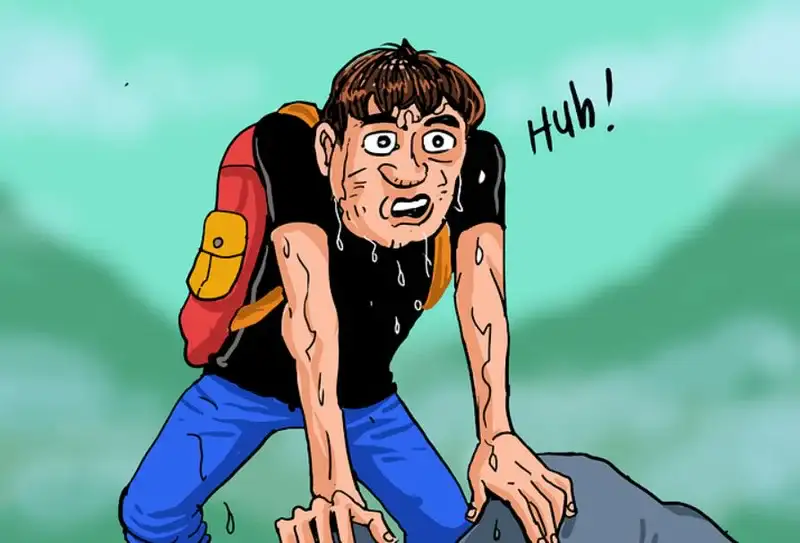Water is usually the heaviest stuff in your backpack and it is also essential, therefore it is important to know the minimum needed, to have it enough and also to avoid carrying an unnecessary weight.
I am sure that there are many possible answers to the question in the title. I am neither a medical doctor nor a nutritionist, but I am a mountaineer.
So from my experience, I never go without a minimum of 1.5 liters per day, usually this is 2-2.5 liters, and sometimes even 2.5-3 liters if this is a very warm day or a very demanding tour.

So now when you multiply this by two, you have the answer. The title above contains the word ‘hike’, but the same would be for backpacking and mountaineering tours.
One of my own recent examples of a two-day tour is the climb to Cima delle Nove, it was an overnight adventure, I slept in the tent and carried everything including water.
What do experts say?
♦ From one source I read: “The U.S. National Academies of Sciences, Engineering, and Medicine determined that an adequate daily fluid intake is:
- About 15.5 cups (3.7 liters) of fluids a day for men.
- About 11.5 cups (2.7 liters) of fluids a day for women.
These recommendations cover fluids from water, other beverages and food. About 20% of daily fluid intake usually comes from food and the rest from drinks.”
So, according to this, and knowing that I am not a woman, I should have died from thirst long ago.
♦ Here is one more source that looks very respectable, but these people are clever. They write that you should “Drink plenty of water throughout the day to avoid dehydration.”
Well, the problem is that they missed to explain what the word “plenty” really means. I told you, clever people, from Harvard University, so what would you expect?
But they even go a step farther and say “No content on this site, regardless of date, should ever be used as a substitute for direct medical advice from your doctor or other qualified clinician.” I am totally impressed. Just to add, the same applies to what I write in this post as my own experience.
♦ Some other source suggests 8×8 formula. This means eight times an 8-ounce glass of water per day. If I am not wrong, this would mean 1.9 liters of water per day. Now, this explains why I am still around and writing these lines.
This would give around 4 liters of water for two days. Sounds reasonable.
What is the reality? What have we learned?
The reality is that we are all different and have different needs, so this is very individual. You cannot rely on somebody’s advise, this can get you in trouble.
From what I know, elderly people will need less liquid. I am in this league.
I would say that if you need more than 3 liters of water per day (6 liters for a two-day tour), you will have a heavy pack. Perhaps you are overweight, or have some other health issues. It would be good to ask a doctor.
How to reduce the water weight in the pack?
In any case, you realize that water adds lots of weight to your pack, this is why it is important to try to reduce the initial amount of water. Here is what I do:
- I know how much I need. So make sure the same holds for you.
- If I know this will be a round tour, I stash some water on the first half of the tour and use it when I am on my way back.
- If I am certain that there are some water sources on the route, I carry a water filter/purifier. There are many options on the market, but make sure you buy something that is reliable. You do not want to take a risk with this.
- So what are reliable water filters’ brands? I would put forward MSR filters above all. See this TrailShot Pocket-Sized Water Filter as a great example:
- It is likely that you will need less liquid in a colder environment and if you do not sweat a lot in general. Perhaps you might need less water if you sweat less and use ventilated backpacks.
Conclusion
In summary, we all have different needs regarding water consumption on a trail. It is therefore advisable that you know yourself and have a clear idea of what you need.
So how to know? If you are a beginner, test yourself in a more controllable environment before you get in trouble.
One more and very important tip: make sure you check your backpack before you set off, and check if all your water supply is indeed there. Here is why.
On my tour to Tresero in the Italian Alps, while descending, I met an elderly man (even from my own perspective) who told me he forgot his water in the car. He did not go to the summit, but he still needed water. I had half a litter extra so I gave hm. He thanked and continued repeating to himself “stupido, stupido…”.
Thank you for reading. For more texts of this type please check under the category FAQs here in the site.
Subscribe to my weekly newsletter, this will keep you informed because I add texts here regularly. Let me know if you have questions or comments, there is a comment box below. Have a nice day.
Leave a Reply